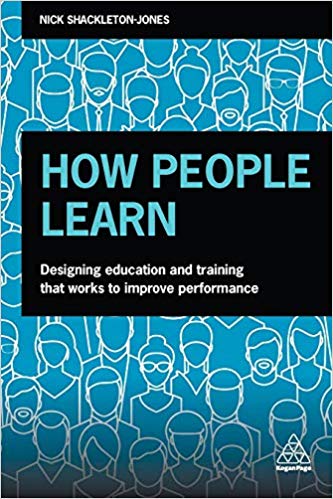How People Learn
Designing Education and Training that Works to Improve Performance


A trained psychologist with substantial experience of the commerical world at Siemens, the BBC and latterly as Director for Learning Technology and Innovation at BP, Nick Shackleton-Jones is currently Director of Learning and Performance Innovation at PA Consulting Group. In 2017 he was awarded the Colin Corder Award for Outstanding Contribution to Learning by the Learning and Performance Institute. Today he also has a growing following as a thought-leader in changing mindsets and adapting practices in corporate learning and development.
Extraordinary amounts of money are invested each year in learning – for children, young adults and in corporate environments for workers, supervisors, managers and senior executives. However, very little thought is given by those being taught about how they learn. Indeed, not nearly enough thought is given by those who do the teaching on how they learn. The vast majority of learning is founded on old models of teaching that have come from Victorian institutions when the focus was prioritised to the efficiency of the learning institution rather than the effectiveness of the tuition. With the explosion of e-learning this model has been adapted, but not substantially altered. It still relies heavily on a learned sage, delivering content from a position of authority.
Shackleton-Jones's disruptive book explodes this model and takes a psychologist's approach to learning. He explains that we learn because we want to – we have an emotional interest in so doing. The book opens with the author taking Hermann Ebbinghaus to task on his famous 'Forgetting Curve', where he measured how long people could remember three-letter phrases, DSF, HWX etc… of course we forget these, Shackleton-Jones declaims – because they are meaningless. If they were replaced with car, dog or hat, we would remember them for longer. This is the basis for his 'affective context' model – that for people to learn they need to have an emotional understanding and connection, however spurious, with the content.
He digs deeper, explaining that as humans we have a capacity to understand the meaning of words that machines do not, which distinguishes learning from just memorizing. We intuitively get that a tree-stump or boulder can be a 'chair' as much as a throne or an Eames chair, where a machine would need countless lines of code to describe each. The reason for this is that we really learn through being open to experience "…education consists of a game in which one memorises information or writes essays in order to pass a test, while learning takes place in bars and halls as young people struggle to find their identity in the midst of social complexity. Learning, as always, is driven by things one cares about".
He expounds on the proximity to need to know something as being a core driver of learning, his learning elimination curve: "the premise is simple: the further away from the point at which people need information you are, the more time and money you are going to waste trying to get people to memorise the information". Today many of us turn to YouTube to understand how to replace a battery in a smoke alarm, or order columns in a spreadsheet or whatever – these are close to need resources, which are hugely effective. Too often learning content is not relevant and does not solve a problem, but continues to be described as a resource, when it is just content.
The second half of the book moves on from explaining the how of learning, to his approach to improving learning design – primarily through his 5Di learning design model: Define – Discover – Design – Develop – Deploy and iterate (continue to improve).
As the world moves quickly to a point where memorising things is becoming largely redundant – Google, Wikipedia and countless other online resources do that better – it will become ever more important for learning to address behaviours and processes. These are not, by any means, optimally taught or developed in classrooms, through reading or listening to gurus from a distance (though he states we do gain substantially more from the emotional effect of listening to 'great people' than hearing their stories second-hand, which is why we intuitively would rather attend a speech by Nelson Mandela, than about him. the status legitimacy effect).
If we are striving to get people to change their behaviours and mindsets then we need to develop them in a way that has affective resonance – has meaning for them. This will focus much more on interaction, discussion, facilitation, coaching and experiencing new sensations and activities. Shackleton-Jones highlights simulations and story-telling alongside anticipation, observation and status as routes to create that meaningful interaction – this book is taking the learning debate into new and fruitful territory.
Title: How People Learn: Designing education and training that works to improve performance
Author/s Name/s: Nick Shackleton-Jones
Publisher: Kogan Page
ISBN: 978-0-749-48470-5
Publishing Date: May, 2019
Number of Pages: 235
Author Knowledge Rating: 1-5 (based on their years of experience, academic expertise in subject areas, and exposure to cross-functional thinking in the area)





















































































Readability: 1-5 score(1=dense and v academic; 5=frantic; page turner)









































































































Appropriate Length: (1=could have been written in 25% of the length;5=could have been longer)









































































































Core Idea Value: (1=nonsense (or entirely esoteric); 5=game-changer)








































































































